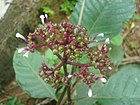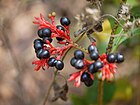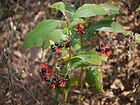Note: This is a project under development. The articles on this wiki are just being initiated and broadly incomplete. You can Help creating new pages.
Rauvolfia serpentina - Sarpa Gandha
Rauvolfia serpentina is a species of flower in the family Apocynaceae. It is native to the Indian subcontinent and East Asia from India to Indonesia.
Contents
[hide]- 1 Uses
- 2 Parts Used
- 3 Chemical Composition
- 4 Common names
- 5 Properties
- 6 Habit
- 7 Identification
- 8 List of Ayurvedic medicine in which the herb is used
- 9 Where to get the saplings
- 10 Mode of Propagation
- 11 How to plant/cultivate
- 12 Commonly seen growing in areas
- 13 Photo Gallery
- 14 References
- 15 External Links
Uses
High blood sugar, Lowering blood pressure, Cataract, Plague, Schizophrenia, Anxiety, Psychosis, Epilepsy, Colic, Cholera, Snake bite , Hypochondria, Mental disorders, Intractable skin disorder, Psoriasis.
Parts Used
Chemical Composition
Ajmaline, ajmalinine and ajmalicine, serpentine, serpentinine, alkaloids, reserpine, rescinnamine and yohimbine.[1]
Common names
| Language | Common name |
|---|---|
| Kannada | Sarpagandha |
| Hindi | Sarpagandha |
| Malayalam | Suvapavalforiyan |
| Tamil | Chivan amelpodi |
| Telugu | Paataala goni |
| Marathi | NA |
| Gujarathi | NA |
| Punjabi | NA |
| Kashmiri | NA |
| Sanskrit | Sarpagandha |
| English | Snake-root |
Properties
Reference: Dravya - Substance, Rasa - Taste, Guna - Qualities, Veerya - Potency, Vipaka - Post-digesion effect, Karma - Pharmacological activity, Prabhava - Therepeutics.
Dravya
Rasa
Tikta (Bitter), Kashaya (Astringent)
Guna
Laghu (Light), Ruksha (Dry), Tikshna (Sharp)
Veerya
Ushna (Hot)
Vipaka
Katu (Pungent)
Karma
Kapha, Vata
Prabhava
Habit
Identification
Leaf
| Kind | Shape | Feature |
|---|---|---|
| Simple | In whorls of 3, thin, lanceolate, acute, bright green above and pale beneath |
Flower
| Type | Size | Color and composition | Stamen | More information |
|---|---|---|---|---|
| Unisexual | 2-4cm long | Violet | 5 | Flowers are in irregular corymbose cymes, white, often tinged with violet. Flowering season is May-January |
Fruit
| Type | Size | Mass | Appearance | Seeds | More information |
|---|---|---|---|---|---|
| Simple | 7–10 mm | Clearly grooved lengthwise, Lowest hooked hairs aligned towards crown | Many | Fruiting season is May-January |
Other features
List of Ayurvedic medicine in which the herb is used
- Vishatinduka Taila as root juice extract
Where to get the saplings
Mode of Propagation
How to plant/cultivate
Its grows spontaneous in tropical forests (temp,10°C to 40°C) which are humid in summer at an altitude up to about 1200 metres.[3]
Commonly seen growing in areas
Trophical region, Borders of forests and fields.
Photo Gallery
References
External Links
- Ayurvedic Herbs known to be helpful to treat High blood sugar
- Ayurvedic Herbs known to be helpful to treat Lowering blood pressure
- Ayurvedic Herbs known to be helpful to treat Cataract
- Ayurvedic Herbs known to be helpful to treat Plague
- Ayurvedic Herbs known to be helpful to treat Schizophrenia
- Ayurvedic Herbs known to be helpful to treat Anxiety
- Ayurvedic Herbs known to be helpful to treat Psychosis
- Ayurvedic Herbs known to be helpful to treat Epilepsy
- Ayurvedic Herbs known to be helpful to treat Colic
- Ayurvedic Herbs known to be helpful to treat Cholera
- Ayurvedic Herbs known to be helpful to treat Snake bite
- Ayurvedic Herbs known to be helpful to treat Hypochondria
- Ayurvedic Herbs known to be helpful to treat Mental disorders
- Ayurvedic Herbs known to be helpful to treat Intractable skin disorder
- Ayurvedic Herbs known to be helpful to treat Psoriasis
- Herbs with Roots used in medicine
- Herbs with common name in Kannada
- Herbs with common name in Hindi
- Herbs with common name in Malayalam
- Herbs with common name in Tamil
- Herbs with common name in Telugu
- Herbs with common name in Sanskrit
- Herbs with common name in English
- Habit - Herb
- Index of Plants which can be propagated by Seeds
- Index of Plants which can be propagated by Cuttings
- Herbs that are commonly seen in the region of Trophical region
- Herbs that are commonly seen in the region of Borders of forests and fields
- Herbs
- Ayurvedic herbs that don't have seed photos
- Apocynaceae







